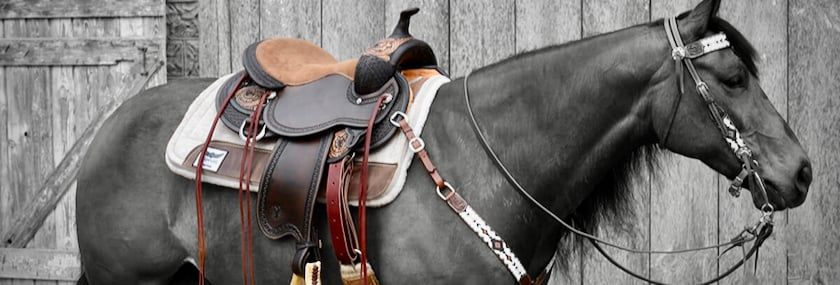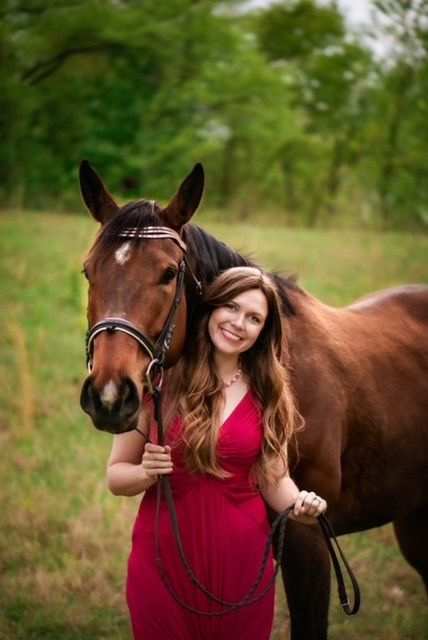Skillful Saddle Selection


Between horse and rider, there’s no one-size-fits-all approach
Your horse’s comfort, happiness and your proper positioning as a rider all weigh on your saddle’s fit. An improper saddle fit causes your weight to be distributed unevenly, which can result in pressure points, rub marks, soreness, or the development of white saddle spots on your horse.
“It is so important to get a saddle that that fits your horse correctly, because it does affect how they move. And it does affect how they feel,” says equestrian and Hooved Animal Humane Society Executive Director, Cynthia Glensgard.
She made a careful selection when choosing a perfect saddle and fit for her and off-track Thoroughbred, Billy Boy.
Everything is interrelated
“Finding the correct saddle that fits your horse, and one that fits you, is really important. It's going to improve your ability to ride correctly, which will improve the horse's balance, which will improve their overall health, their muscle conditioning, their tone…everything is just interrelated,” said Glensgard.
Having recently went through the saddle selection process, she expressed the changes she has already seen in her horse.
“Just having the correct saddle changed how he moves. He moves much more freely, is much more supple and he doesn't hurt. It’s like putting on tennis shoes that are too tight or high heels that are too small—nobody wants that. So, I would say to really take the time to ensure you’re ordering the right saddle and fit.”
Be sure to monitor your horse’s attitude and behavior while riding, which can clue you in on a painful saddle fit, but keep in mind: Some horses are more stoic than others.
Your horse’s saddle fit is an important part of their comfort and performance, as well as your success as a rider.
Fast facts on saddle fit
The tree size determines saddle fit on the horse's back. There is no standardization in the industry for tree size, thus the fit may also vary among disciplines.
- Your saddle fits just right if it sits level on your horse’s back and the bars of the tree do not pinch. The front of your saddle should be positioned behind your horse’s shoulder blade, allowing him freedom of movement.
- Your saddle is too narrow if the front of the saddle sits high. When the saddle is sitting directly upon the horse’s withers, pinching can often occur.
- Your saddle is too wide if the front of the saddle is low. This also results in pinching but at the top of the saddle’s bars. The gullet of the saddle may be too low and rest on your horse’s withers causing pain and discomfort.
The gullet measurement is from the bare tree, not with the leather on the saddle. Measure down from your horse’s withers, and make sure your fork, pommel or gullet clear the area by the width of three fingers. Be mindful of saddles that are too long to avoid harming your horse. The 18th vertebrae is the back of the saddle support area.
Glensnard advises: “I would say the best thing that you could do would be to take the time and if you don't have access to a professional saddle fitter, go online, find some information, articles and videos to watch on saddle fitting. There are a lot of things that you can do yourself to make sure that the saddles you're looking at actually do fit your horse, because it's not a one-size-fits-all thing.”
Care is part of the fit
Remember that the longevity of your saddle and tack all depends on how well it is cared for over the years. Cleaning and oiling your tack regularly help to prevent cracking and protect the leather. Oiling your saddle also aids in a safer ride, as dry, cracked leather can result in breakage, which can potentially lead to a mishap and rider injury.
For safety, closely observe your tack and the quality of your leather pieces. Are they oiled and secure, without any sign of dry rot or cracking? If so, happy trails.
If not, for the safety of your ride, it is time for repair or replacement.
Learn more
Find more about proper saddle fit at ValleyVet.com/Education
Tags:Horse Sense

Acreage Life is part of the Catalyst Communications Network publication family.














